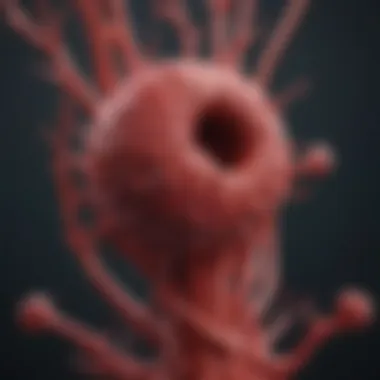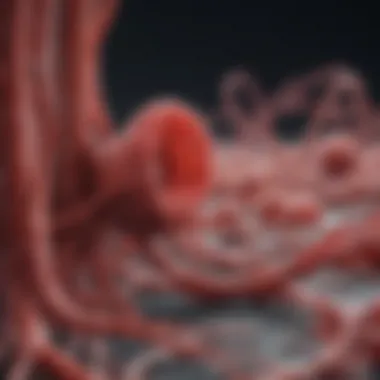Visual Characteristics of Blood Clots Explained


Intro
Blood clots are not merely a biological response; they are complex structures that reflect the intricate processes of the human body. Understanding their visual characteristics is essential for a comprehensive grasp of their role in health and disease. In this article, we will delve into the formation, types, and implications of blood clots. By analyzing the physiological and morphological properties of clots, we aim to illuminate their significance in medical diagnostics and clinical practice.
Research Background
Overview of the Scientific Problem Addressed
Blood clotting, known medically as coagulation, is vital for preventing excessive bleeding. However, improper clot formation can lead to severe medical conditions, like deep vein thrombosis or pulmonary embolism. Understanding the visual characteristics of these clots is crucial for accurate diagnoses. Visual analysis can provide insights into thrombus composition and potential risks associated with various types of clots.
Historical Context and Previous Studies
Historically, blood clots were often evaluated based on their general appearance and location. Advances in technologies, such as imaging and microscopy, have revolutionized this field. Research has identified numerous clot types, categorized primarily by size, color, and texture. Early studies laid a foundation, but the nuances in clot formation and their implications on health needed further exploration.
Findings and Discussion
Key Results of the Research
Studies have demonstrated that the color of blood clots can range from bright red to dark brown, depending on the hemoglobin content and age of the clot. Fresh clots often appear red due to high red blood cell concentration, while older clots take on a darker hue as oxygen levels decrease and cellular breakdown occurs. Moreover, the texture can vary from soft and jelly-like to hard and fibrous, indicating different stages of clot maturation.
Interpretation of the Findings
The appearance of blood clots can be indicative of several factors. For instance, a dense clot may suggest a higher risk of complications. Clinicians use these visual markers in conjunction with other diagnostic tools to make informed decisions about patient care. Visual characteristics also assist in distinguishing between various types of clots, which can have different treatments and outcomes. Thus, understanding the phenotypic expressions of clots is integral to modern medical diagnostics.
The visual characteristics of blood clots are not merely aesthetic; they serve as critical indicators of underlying health issues and can impact treatment strategies.
Prelims to Blood Clots
Blood clots play a vital role in the body’s ability to heal. Understanding blood clots is essential for both healthcare professionals and patients. This knowledge can lead to better outcomes in various scenarios, including surgeries, trauma care, and the management of chronic conditions.
Clotting involves a complex series of physiological processes that contribute to wound healing and prevention of excessive bleeding. By grasping how blood clots form, their types, and their characteristics, one can appreciate their significance in medical diagnostics and treatment plans.
Definition of Blood Clotting
Blood clotting, or coagulation, is a mechanism whereby blood changes from a liquid state to a gel-like state. This transformation is critical after an injury or a breach in the integrity of blood vessels. The formation of a clot is primarily a response to bleeding, involving blood platelets and proteins in the plasma. When a vessel is damaged, platelets are activated and adhere to the exposed site.
In response, the body initiates a cascade of enzymatic reactions that convert fibrinogen, a soluble plasma protein, into fibrin. Fibrin strands weave through the platelet plug, creating a stable and solid structure that halts blood loss. This physiological process is crucial during trauma but can also lead to complications if it occurs inappropriately.
Physiological Role of Blood Clots
The physiological role of blood clots extends beyond just stopping bleeding. Clots serve several important functions:
- Wound Healing: They create a barrier at injury sites, allowing tissues to begin healing. This protects the underlying structures from infection and further damage.
- Preventing Blood Loss: By stopping bleeding, clots maintain blood volume and pressure, essential for proper circulation and organ function.
- Initiating Healing Process: The clotting process releases signaling molecules that attract cells involved in tissue repair, such as leukocytes and fibroblasts.
However, inappropriate clotting can lead to health issues. Conditions such as thrombosis can arise when clots form without a triggering injury.
"Effective understanding of blood clot mechanisms is crucial in preventing and managing conditions associated with abnormal clotting."
This knowledge underlines how blood clots, while necessary for survival, also need careful regulation to prevent complications in health care settings.
Types of Blood Clots


Understanding the types of blood clots is essential, particularly for medical professionals and researchers. The variations in blood clots can influence their behavior, formation mechanism, and implications for health. Recognizing the distinctions among venous, arterial, and microvascular clots allows for better diagnostics and treatment strategies.
Venous Clots
Venous clots form in the veins, usually in the lower extremities. They are often associated with conditions such as deep vein thrombosis (DVT), which can lead to serious complications if untreated. The primary cause of venous clots is the stasis of blood flow, commonly due to prolonged immobility or other risk factors like obesity.
Visually, venous clots typically appear dark red or purple due to the deoxygenated blood they contain. The texture can be gelatinous and soft, which reflects the composition of the clots, including fibrin and red blood cells. Clinicians often rely on imaging techniques like ultrasound to diagnose these clots, considering their visual characteristics and associated symptoms, such as swelling and pain.
Arterial Clots
Arterial clots occur in the arteries, where they can obstruct blood flow, leading to conditions like myocardial infarction or stroke. These clots form primarily due to plaque rupture, a process involving cholesterol build-up and inflammation. The resulting clot can quickly lead to significant loss of blood flow, which is often life-threatening.
In terms of appearance, arterial clots are commonly lighter in color compared to venous clots, leaning towards a bright red due to the oxygenated blood they contain. Their texture is generally firmer and more structured, including platelets and fibrin. Educating patients about the signs of arterial clots is vital. Symptoms may include chest pain, shortness of breath, or sudden weakness.
Microvascular Clots
Microvascular clots, as the name suggests, occur in the smallest blood vessels. Their formation is often linked to systemic conditions like sepsis or disseminated intravascular coagulation (DIC). While they may not be visible without advanced imaging techniques, understanding their characteristics is important given their potential to cause widespread ischemia.
These clots can vary in appearance but are often fine and may not adhere well to the vessel walls. Due to their size, they may be missed in traditional assessments. However, their presence can lead to significant implications for organ function. They highlight the need for continuous monitoring of coagulation status in critically ill patients.
The distinct types of blood clots have implications that extend beyond their immediate effects, influencing treatment and management approaches.
In summary, the types of blood clots—venous, arterial, and microvascular—each have unique characteristics that impact both diagnostics and clinical outcomes. Recognizing these differences is crucial for effective medical practice and research.
Visual Characteristics of Blood Clots
Notably, the visual aspects of blood clots encompass three main elements: color and texture, shape and size, and the age of the clot. Each of these characteristics reveals critical information about the clot’s formation, its potential impact on health, and necessary interventions. In clinical settings, these details are not trivial; they may reflect the effectiveness of treatment or indicate a need for more aggressive management practices.
By analyzing the intricate visual features of blood clots, one can gain a more nuanced understanding of their implications in health and disease. This understanding not only informs clinical decisions but also lays the groundwork for further research and innovation in mechanisms of clot formation.
Color and Texture
The color and texture of blood clots are of paramount importance. Fresh clots tend to exhibit a bright red hue due to the presence of oxygen-rich red blood cells. This vibrant color can shift to darker shades of red or even brown as the clot matures and deoxygenates. Understanding this color change can aid in the assessment of the clot's age and stability.
Texture also plays a critical role. Fresh clots are often soft and gel-like, while older clots become more firm and fibrous. This change is due to fibrin polymerization, a process where fibrin strands knit together, securing platelets in place. Analyzing both color and texture can provide information on how long a clot has been in place and whether it is still active in a patient’s cardiovascular system.
Shape and Size
Blood clot shape and size vary significantly depending on the location and type of clot. Venous clots often have a more irregular, branching shape, while arterial clots typically present as more spherical formations. The size can also vary widely, from small, insignificant clots to larger, more concerning formations that can obstruct blood flow.
Clinicians must carefully evaluate these characteristics, as they can be indicators of the underlying pathology. For example, larger clots in arteries often suggest acute events, which might lead to serious complications. Conversely, smaller venous clots may lead to different risks, such as deep vein thrombosis. Adequate assessment of shape and size is vital to ensuring proper treatment protocols are followed.
Age of the Clot
The age of the clot is another crucial aspect when evaluating blood clots' visual characteristics. Fresh clots are typically red and more pliable, indicating recent formation. In contrast, older clots change color, often becoming darker or even adopting a brownish tint, and they also undergo a transformation in texture from soft to firm and sticky.
Recognizing the age of a clot can assist in determining the necessary interventions. For instance, a fresh clot might be more amenable to pharmacological thrombolysis, whereas an older clot might require different management strategies. By understanding the progression of clot formation, medical professionals can make better-informed decisions regarding patient care.
The visual characteristics of blood clots are essential for diagnosing and managing thrombotic events effectively. Not only do they influence immediate treatment options, but they also provide insight into the underlying pathophysiology of clot formation.
In summary, the visual characteristics of blood clots play a significant role in assessing their implications in clinical practice. By focusing on color, texture, shape, size, and age, healthcare professionals can better understand and manage thrombotic conditions.


Factors Influencing Appearance of Blood Clots
The appearance of blood clots is not random. It is significantly shaped by various factors that interplay during their formation and evolution. Understanding these factors is key in comprehending the visual characteristics of blood clots. Each influencing element contributes uniquely to the structure and coloration of any clot, which can serve vital roles in medical diagnostics.
Imaging Techniques for Blood Clots
Imaging techniques for blood clots play a critical role in medical diagnostics. The ability to visualize blood clots is essential for proper diagnosis and management of conditions such as thrombosis. Various imaging modalities exist, each with distinct benefits and limitations that should be thoughtfully considered in the clinical setting. Understanding these techniques allows healthcare professionals to choose the most appropriate method for their patients, ultimately impacting treatment outcomes.
Ultrasound Imaging
Ultrasound imaging, or sonography, is a commonly used method for detecting blood clots, especially in veins. This non-invasive technique employs high-frequency sound waves to create images of the blood vessels. One of its primary advantages is the ability to perform real-time assessments, making it invaluable in emergency situations.
Ultrasound can effectively identify deep vein thrombosis by demonstrating the presence of a clot within veins. It also offers a way to guide further interventions, such as catheter placements. However, this technique has limitations. For instance, it may not provide clear images for clots located in areas with complex anatomy. Additionally, operator skill can significantly affect the outcomes of this imaging method.
CT Scans
Computed Tomography (CT) scans provide another effective means to visualize blood clots. This imaging technique produces detailed cross-sectional images of the body and can reveal clots in arteries or veins quickly. The CT pulmonary angiogram is commonly employed to diagnose pulmonary embolism, a serious condition where clots travel to the lungs.
CT scans offer precise localization of clots and can assess the extent of clot burden. Furthermore, contrast agents are often used to enhance vascular structures on imaging. Nevertheless, this method has drawbacks. The exposure to ionizing radiation can be a concern, especially for repeated imaging. Also, patients with allergies to contrast media may require alternative imaging strategies.
MRI Techniques
Magnetic Resonance Imaging (MRI) is another imaging modality used in specific cases of clot assessment. MRI employs strong magnetic fields and radio waves to create detailed images of soft tissues. It is particularly useful for visualizing clots in cases of cerebral vein thrombosis, providing excellent contrast between blood clots and surrounding tissues.
The strength of MRI lies in its lack of ionizing radiation, making it safer for repeated use. Additionally, MRI can assess both the clot's age and the associated brain structure changes. However, MRI can be time-consuming and less accessible than ultrasound or CT. Patients with certain implants or devices may also be ineligible for this imaging technique.
Each imaging technique offers unique benefits and challenges that must be weighed carefully in clinical practice. Choosing the right method ensures accurate diagnosis and effective management of blood clots.
Clinical Significance of Blood Clot Appearance
Diagnosis of Thrombosis
Diagnosing thrombosis can often be a challenging aspect of medicine. The visual attributes of blood clots provide essential clues to healthcare professionals. For instance, the composition and age of the clot can help differentiate between recent and old clots. A fresh clot, often bright red and soft, indicates active bleeding and an acute thrombotic event. In contrast, older clots tend to appear darker and firmer. Understanding these distinctions is vital during imaging and interventions.
"The visual characteristics provide immediate insights into the clot's nature, paving the way for prompt clinical decisions."
Radiology departments use ultrasound imaging specifically to assess clot appearance. Potentially, this can guide near-instantaneous decisions about whether to treat a patient with anticoagulants or prepare for surgical intervention. Not only does the appearance aid in thrombosis diagnosis, but it also supports evaluating the effectiveness of ongoing treatment.
Indicator of Underlying Conditions
The visual characteristics of blood clots are often indicative of various underlying health conditions. Certain conditions, like thrombophilia or cancer, can cause the body to create abnormal clot formations. For example, a arterial clot stemming from atherosclerosis may showcase distinct features compared to a clot formed due to an imposed stress from a deep vein thrombosis. These visual cues can prompt further exploration into a patient's health status.
By recognizing patterns in clot formation and color, clinicians can identify possible risk factors in patients. Such understanding may lead to the diagnosis of conditions that would otherwise remain unnoticed. Anomalies in clot appearance often prompt necessary testing and evaluations, ensuring timely treatment. Additionally, visual knowledge of clots enables a connection between clots and conditions such as diabetes or hypertension, indicating a greater risk of cardiovascular events.
Through careful observation and analysis, health professionals can transform these visual cues into actionable insights, guiding further clinical investigations and personalized treatment approaches.
Blood Clot Discoloration and Its Implications
Blood clot discoloration is a key area of interest in understanding blood clots. This section explores how color changes in blood clots can indicate various physiological states and their possible implications for patient health. The visual changes provide insights into the age, composition, and potential risks associated with clots. By examining these discolorations, healthcare professionals can enhance diagnostic processes and treatment strategies. Understanding these aspects is essential for effective patient care and offers valuable information for ongoing research in hematology.
What Leads to Discoloration


Discoloration of blood clots can arise from several factors. Here are some critical elements that contribute to these changes:
- Oxygenation Levels: Initially, fresh blood clots are bright red due to oxygen presence. As they age and become deoxygenated, they turn darker, leading to a reddish-brown color.
- Composition Changes: The breakdown of blood cells, particularly red blood cells, can influence clot color. As these cells degrade, hemoglobin is released and subsequently breaks down into various pigments, such as bilirubin, which can alter the color further.
- Absorption and Reflection of Light: The physical properties of the clot determine how light interacts with it. The formation of fibrin strands and their density can affect how blood clots absorb and reflect light, thus altering perceived color.
- Site of Formation: The location where a clot forms also plays a role. Clots in veins often have a different composition compared to those in arteries due to varying blood pressures and speeds of flow.
"The visual characteristics, including discoloration, can be critical for diagnostics in clinical practices."
Clinical Implications of Changes in Color
Changes in blood clot color have significant clinical implications. These can assist in various aspects of patient care:
- Age Assessment: Darker clots typically indicate older clots, which may suggest that they are more stable or that anticoagulation therapy has slowed their growth, aiding in treatment planning.
- Potential Complications: If a clot appears unusually discolored or shows signs of fragmentation, it may indicate complications, such as thrombosis or embolism. Clinicians may need to intervene based on these visual cues.
- Diagnosis of Underlying Conditions: Certain diseases can affect clot formation and color. For instance, liver disease may lead to abnormal coloration due to compromised clotting factors.
- Guiding Treatment Decisions: Understanding the color of a clot can help inform treatment options. For example, if a clot becomes less red due to cellular degradation, this could prompt considerations for adjusted anticoagulation strategies.
The visual assessment of clot discoloration therefore serves as a valuable tool in clinical settings, aiding in diagnosis and management.
Prevention and Management of Blood Clots
When discussing blood clots, understanding their prevention and management is crucial. The formation of blood clots can lead to serious health issues, such as thrombosis and embolism. These complications can have severe consequences, including stroke or pulmonary embolism if not addressed effectively. Therefore, preventative measures and treatment protocols play a critical role in maintaining vascular health and preventing the detrimental impacts of clots.
Preventative Measures
Preventing blood clots revolves around several key factors. Awareness and proactive health management can significantly reduce the risk of clots forming. Here are some preventative measures:
- Regular Physical Activity: Engaging in regular exercise helps maintain circulation and prevents stagnation of blood, which is a primary risk factor for clot formation. Simple activities like walking or cycling can be very effective.
- Weight Management: Obesity is a considerable risk factor for blood clots. Maintaining a healthy weight reduces pressure on the veins and promotes better circulation.
- Hydration: Ensuring adequate fluid intake can help keep blood thin. Dehydration can lead to thickening of blood, increasing clot risk.
- Avoiding Prolonged Inactivity: Long periods of sitting or immobility, such as during long flights, can raise the likelihood of thrombus development. It is advisable to take breaks and move around often.
- Medications: For individuals at high risk, doctors may prescribe anticoagulants or antiplatelet agents. These medications help maintain blood flow and prevent clotting. Always consult with a healthcare professional prior to starting any medication.
It is important to recognize these measures not as one-size-fits-all but as tailored approaches based on an individual’s health history and risk factors.
Treatment Options
In case of existing blood clots, timely treatment is essential to prevent complications. Here are some of the primary treatment options available:
- Anticoagulants: These blood-thinning medications, such as warfarin or rivaroxaban, help disrupt the clotting process and reduce clot growth. The intent is to prevent further clots and facilitate the body’s natural clot dissolution over time.
- Thrombolytics: Also known as “clot busters,” these drugs are used in more severe cases to dissolve clots quickly. They are particularly useful in emergencies, such as a heart attack or severe pulmonary embolism.
- Compression Therapy: This involves using compression stockings. Such devices help improve blood flow in the legs and reduce the chances of clot formation.
- Surgical Interventions: In extreme cases, procedures may be necessary to remove the clots mechanically. Procedures like catheter-directed thrombolysis are used to treat large clots that pose immediate risks.
"Prevention is the key. Knowing your risk factors and management strategies can save lives."
Understanding how to manage and prevent blood clots can empower individuals to take control of their vascular health. By recognizing risk factors, implementing preventative measures, and seeking appropriate treatment where necessary, the dangers posed by blood clots can be significantly mitigated.
Future Directions in Clot Research
Research on blood clots continues to evolve, driven by advancements in technology and a deeper understanding of the physiological mechanisms involved in clot formation and resolution. Future directions in this field are crucial not only for enhancing the accuracy of diagnostics but also for improving treatment options and overall patient outcomes. With various emerging technologies and innovative strategies on the horizon, the potential for significant breakthroughs in the management of blood clots appears promising.
Emerging Technologies for Detection
The quest for better detection methods has led to several exciting technologies that hold promise for the future of clot research.
These include:
- Point-of-Care Testing Devices: Devices that can rapidly assess clot status using a small blood sample may soon enter widespread clinical use.
- Artificial Intelligence: Machine learning algorithms can analyze imaging data more efficiently, identifying clots that may go undetected by human interpretation.
- Biomarkers: New research is focusing on identifying specific proteins or genetic markers in blood that could indicate the presence of a clot, offering a more sensitive detection approach.
These technologies aim to provide faster and more accurate identification of clots. Faster detection means earlier interventions, which can significantly improve patient outcomes.
Innovations in Treatment Strategies
Treatment strategies for blood clots are also evolving. Current approaches often include anticoagulants, but there is a push towards more innovative solutions. Emerging strategies include:
- Nanotechnology: This involves the development of nanoparticles that can specifically target clots for drug delivery. This could enhance the effectiveness of treatment while reducing side effects.
- Biological Therapies: Research is focusing on developing drugs derived from natural substances that can optimize the body's ability to dissolve clots safely.
- Customized Treatment Plans: Advancements in genomics may lead to personalized treatment strategies tailored to an individual’s genetic makeup, thus improving the efficacy of interventions.
"The landscape of clot research is rapidly changing, presenting new possibilities in detection and treatment that could reshape clinical practices."
In summary, the future of clot research holds much promise. The combination of improved detection technologies and innovative treatment methods may lead to better management of blood clots and ultimately improve patient care.







